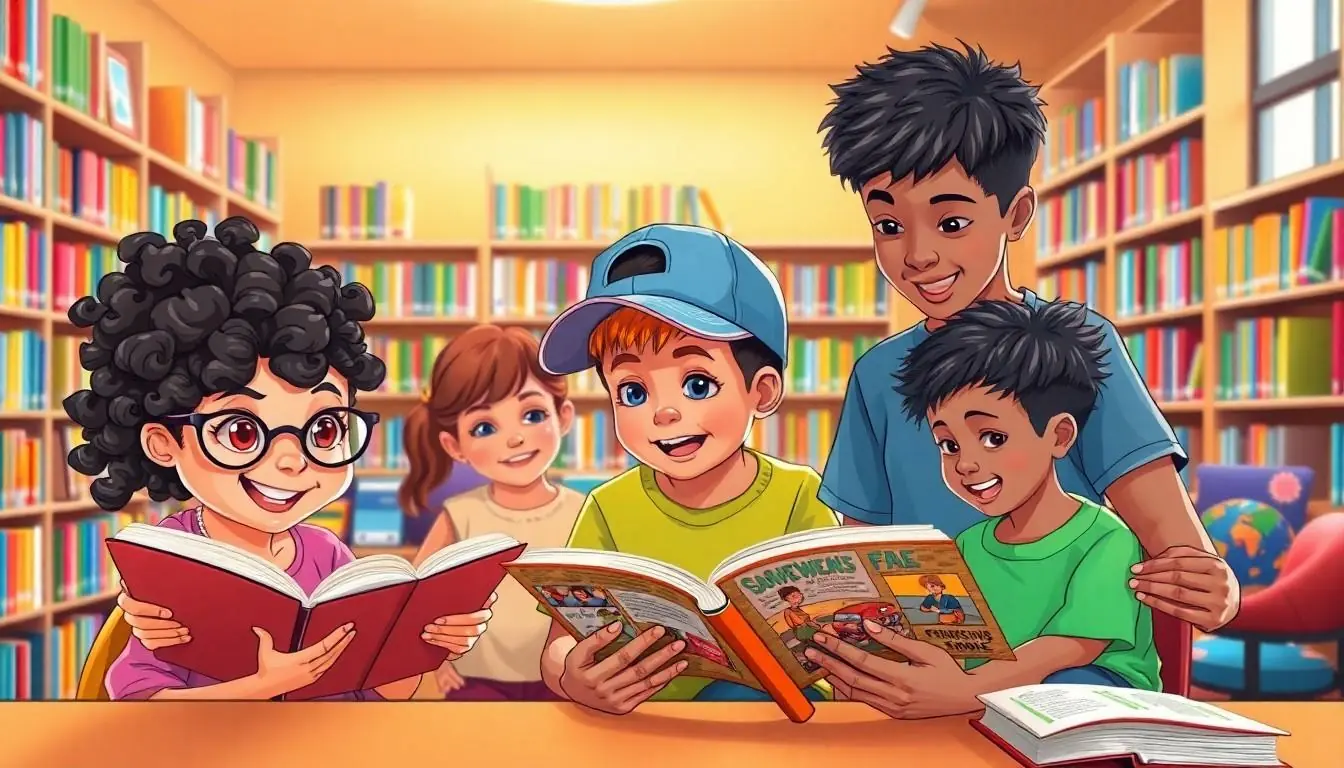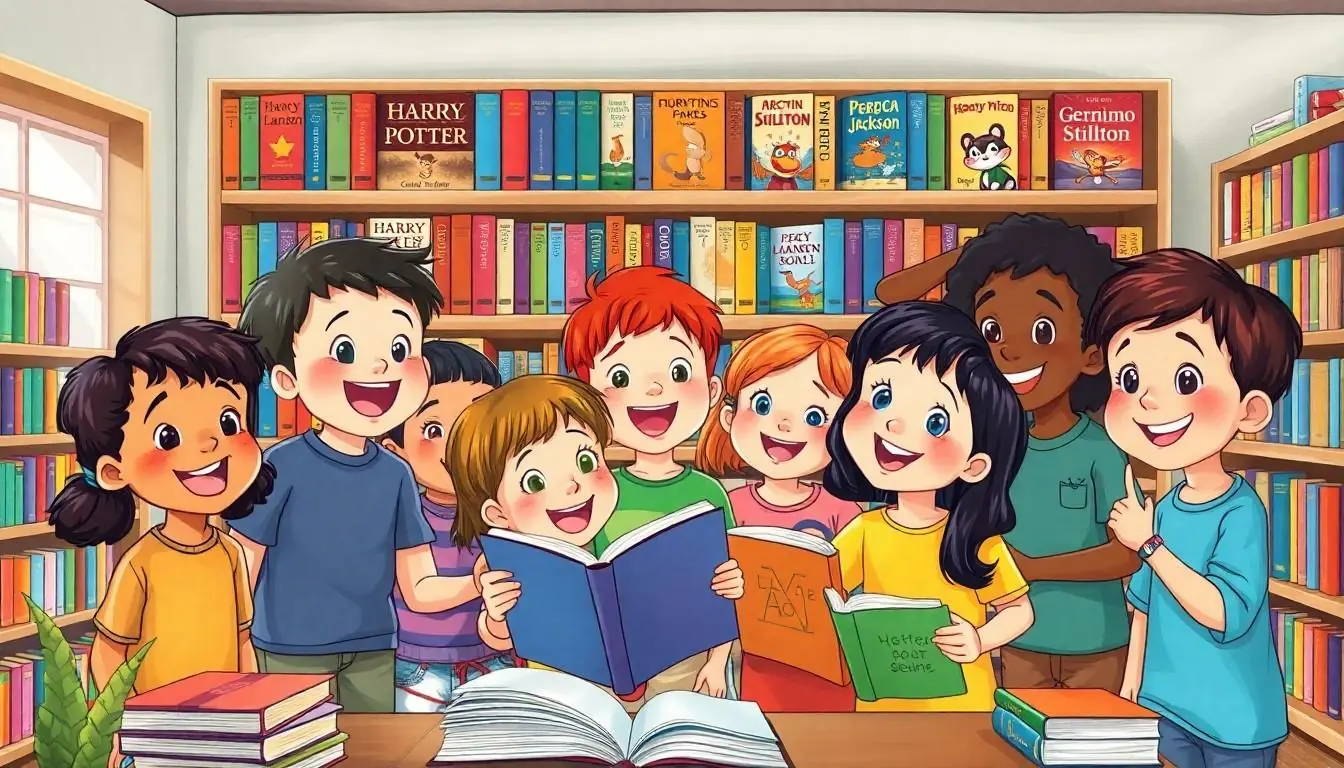Remember the thrill of diving into a new book during those carefree elementary school days? For kids in the 2000s, the library was a treasure trove filled with magical worlds and unforgettable characters. From quirky adventures to heartwarming tales, these books not only sparked imaginations but also created lifelong readers.
Table of Contents
ToggleOverview of Elementary School 2000s Kids Books
Elementary school kids in the 2000s enjoyed a diverse range of books that captured their imaginations. Popular series included Harry Potter, which introduced magical worlds and complex characters. Titles like The Magic School Bus provided educational adventures, blending learning with fun.
Fantasy genres thrived, featuring works from authors like J.K. Rowling and Eoin Colfer. Readers explored themes of friendship, bravery, and personal growth through beloved characters. Graphic novels gained traction, with series such as Bone captivating young audiences with their illustrations and storytelling.
Realistic fiction also made a significant impact. Books like Wonder by R.J. Palacio raised awareness about bullying and acceptance. These narratives encouraged empathy, guiding children to understand diverse perspectives.
In nonfiction, series like Who Was? provided accessible biographies, sparking curiosity about historical figures. These engaging accounts inspired children to learn about science, history, and culture in an entertaining format.
The 2000s marked a shift in children’s literature. Publishers began prioritizing diversity in stories, reflecting wider cultural experiences. Titles featuring protagonists from various backgrounds showcased different voices, allowing more children to see themselves in literature.
Book fairs and reading programs fueled this literary excitement. Young readers eagerly anticipated events, where new releases and popular series thrived. Libraries remained essential spaces for exploration, stocked with a rich array of stories that fostered lifelong reading habits.
Overall, elementary school kids’ books from the 2000s significantly shaped their reading experience. These books provided not just entertainment, but also critical life lessons and a sense of connection through shared stories.
Popular Series of the 2000s
The 2000s introduced a wealth of captivating children’s book series that engaged young readers. These series varied in themes, encompassing fantasy, adventure, and mystery.
Harry Potter Phenomenon
J.K. Rowling’s Harry Potter series became a cultural milestone. Magical adventures centered around Harry and his friends offered readers an escape into a richly woven fantasy world. Themes of friendship, courage, and the battle between good and evil resonated with millions. Each book featured intricate plots that kept kids eagerly turning pages. The popularity sparked midnight release parties and global merchandise sales, showcasing its far-reaching impact.
Percy Jackson Adventures
Rick Riordan’s Percy Jackson and the Olympians series introduced readers to a unique blend of mythology and contemporary adventure. Young demigods battled ancient Greek monsters while navigating the trials of adolescence. Percy Jackson’s relatable struggles helped children connect with heroic journeys. The series promoted interest in mythology and history through engaging storytelling. Readers couldn’t put down these exhilarating tales, leading to adaptations across various media platforms.
Geronimo Stilton Stories
The Geronimo Stilton series captivated young readers with its quirky humor and vibrant illustrations. Stories followed the adventures of a mouse journalist, Geronimo, as he uncovered mysteries and explored thrilling locales. Readers enjoyed the series’ interactive elements, like colorful text and side notes enhancing the experience. Engaging plots encouraged kids to read actively and build vocabulary. This blend of fun and adventure made Geronimo Stilton a staple on library shelves.
Memorable Standalone Books
Standalone books from the 2000s offered captivating stories that resonated with elementary school kids. These titles created lasting memories and sparked imaginations.
The Tale of Despereaux
“The Tale of Despereaux” by Kate DiCamillo tells the story of an adventurous mouse and his quest for love and honor. This enchanting tale weaves themes of bravery, forgiveness, and friendship. Young readers connected with Despereaux’s unique character traits and the challenges he faced. He offered a refreshing perspective on heroism, breaking conventional mold. The book’s beautiful illustrations complemented the narrative, captivating audiences even further. Readers often cherished its blend of whimsy and life lessons, making it a beloved choice for elementary classrooms.
Holes by Louis Sachar
“Holes” by Louis Sachar follows the journey of Stanley Yelnats, a boy sent to a juvenile detention camp. This novel features a mix of mystery and adventure, engaging readers through its clever plot twists. Stanley’s story intertwined with historical elements, creating a rich narrative tapestry. Flashbacks to his ancestors add depth to the storyline and intrigue to the reader experience. Besides entertainment, “Holes” delivers messages about fate, friendship, and perseverance. Kids found inspiration in Stanley’s growth throughout his trials at Camp Green Lake, resonating with his determination to overcome obstacles.
Themes and Trends in 2000s Kids Literature
Exploring the key themes and trends in children’s literature from the 2000s reveals compelling connections among friendship, adventure, diversity, and inclusion.
Friendship and Adventure
Friendship and adventure defined the landscape of 2000s children’s literature. Popular series like Harry Potter showcased the importance of strong bonds among characters, emphasizing loyalty amid challenges. Characters faced various obstacles, forging friendships that underscored themes of courage and teamwork. Percy Jackson and the Olympians highlighted heroic journeys where friends supported one another, blending mythology with relatable contemporary challenges. Stories frequently emphasized the exploration of fantastical worlds, where adventure was a catalyst for character development and deeper relationships. These narratives resonated with young readers, inviting them to embark on their own imaginative quests while cultivating a stronger sense of camaraderie through shared stories.
Diversity and Inclusion
Diversity and inclusion gained prominence in 2000s kids literature, reflecting broader societal changes. The rise of representation allowed children of various backgrounds to see themselves in stories. Authors like R.J. Palacio wrote books that promoted empathy and understanding, with titles such as Wonder addressing themes of acceptance and kindness. Characters from various cultures were featured, enriching narratives with their unique experiences. Series like The Magic School Bus introduced educational elements while promoting curiosity about different perspectives. These developments encouraged discussions around kindness and respect, paving the way for a more inclusive literary landscape. As children engaged with these diverse stories, they cultivated a deeper understanding of the world around them.
Impact on Today’s Children’s Literature
The influence of 2000s children’s books remains strong in contemporary literature. Many themes from that era, such as friendship and adventure, continue to resonate with young readers today. Classic series like Harry Potter and Percy Jackson set a standard for character-driven narratives that emphasize teamwork and courage. Authors draw inspiration from these works, crafting compelling characters that promote essential values.
Diversity in children’s literature gained traction in the 2000s, paving the way for richer storytelling. The success of diverse titles allows authors to address a wider array of backgrounds and experiences. Books like Wonder encourage empathy and understanding, while introducing young readers to various perspectives. Publishers prioritize inclusivity, recognizing its importance in shaping future readers’ worldviews.
Innovative formats also emerged during this period. Graphic novels like Bone captivated an entirely new generation, illustrating how visual storytelling can engage young minds. This trend continues, with many authors integrating visual elements to enhance traditional narratives, appealing to both reluctant and eager readers.
Educational content found its place alongside captivating stories in the 2000s. Series like The Magic School Bus fused learning with entertainment, demonstrating that educational books can inspire a love for reading. This blend of genres persists, with many modern authors weaving lessons into imaginative tales, shaping an enduring legacy of literature aimed at developing inquisitive minds.
Constant evolution defines children’s literature today, influenced by the foundational texts from the 2000s. Engaging stories and relatable characters reflect a commitment to foster a lifelong love for reading. With ongoing advancements, today’s literature builds upon these early examples, ensuring that young readers continue to find joy in exploration and discovery.
Conclusion
The 2000s marked a transformative era for children’s literature that continues to influence young readers today. The enchanting stories and diverse characters from this time laid the groundwork for a love of reading that many carry into adulthood.
As children explored fantastical worlds and relatable themes they developed empathy and curiosity about the world around them. The evolution of storytelling during this decade ensured that every child could find a piece of themselves within the pages.
Ultimately the legacy of 2000s children’s books remains vibrant enriching the literary landscape and inspiring new generations to embark on their own adventures through reading.





